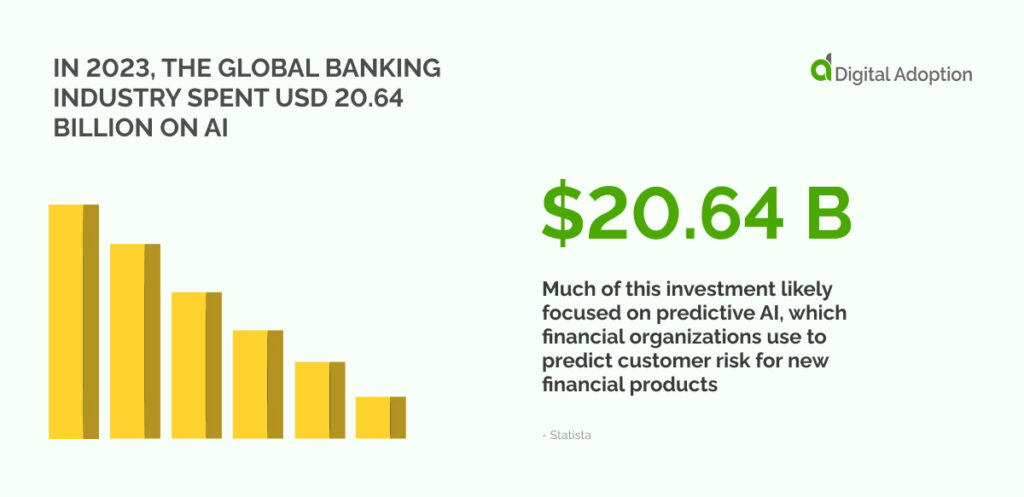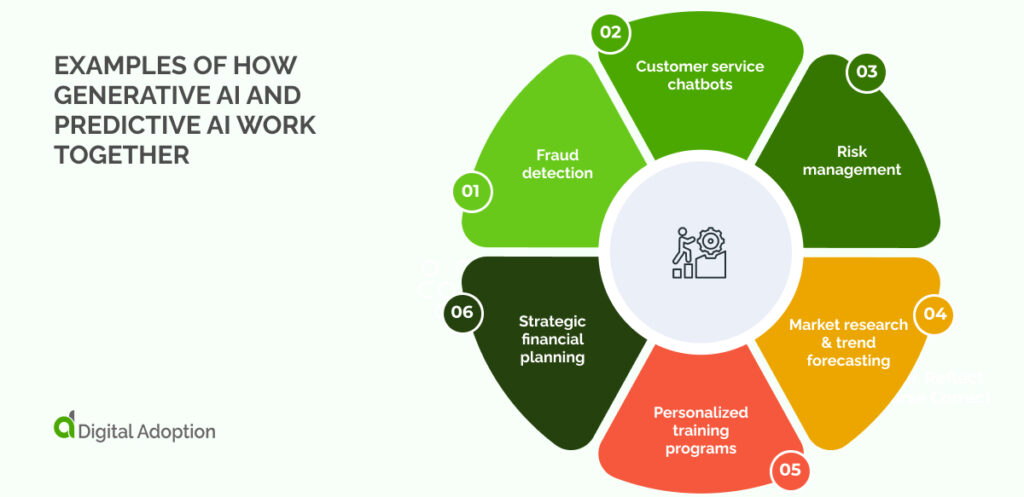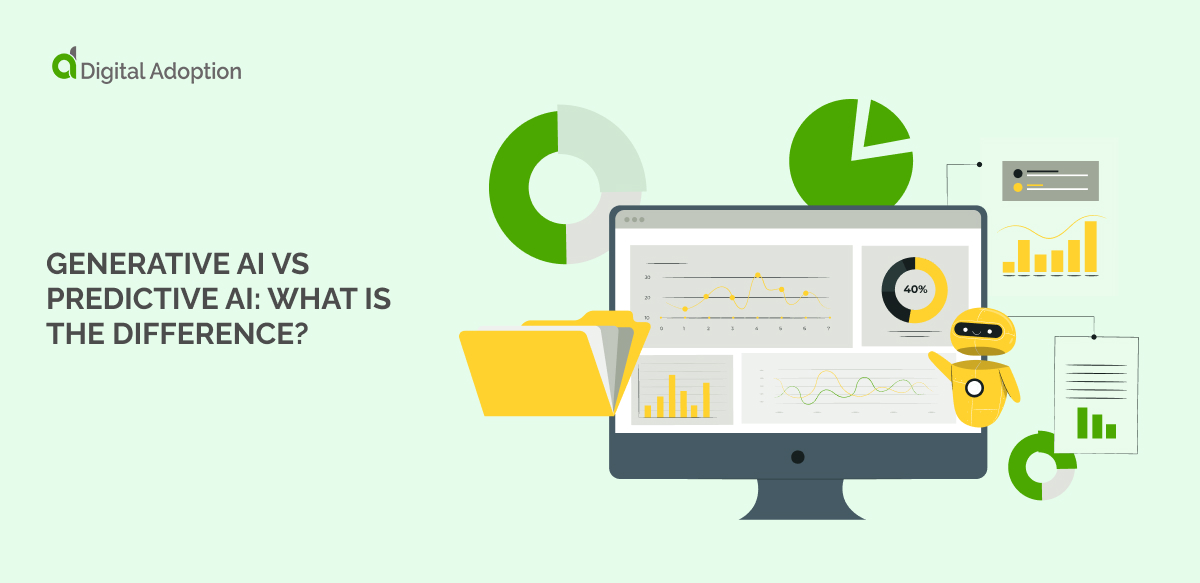In 2023, almost a third of companies were using generative AI in some form. It is essential to consider generative AI versus predictive AI and how they can work together.
Most enterprises haven’t considered how to use these technologies together, so knowing this information can help you come out on top.
In 2023, the global banking industry spent USD 20.64 billion on AI. Much of this investment likely focused on predictive AI, which financial organizations use to predict customer risk for new financial products.

However, despite steady upticks in AI adoption statistics, not every enterprise has adopted these disruptive technologies, and many fewer have combined them. So, it is still common not to know the difference between tools like generative AI and predictive AI.
First, we will explore definitions of generative and predictive AI. Next, we will examine the differences between these two tools and finish with AI examples of how these tools can work together. Begin your AI-driven digital transformation today with this combination made in heaven.
What is generative AI?
Generative AI uses large language learning models to collect large amounts of data and generate high-quality paragraphs, images, and even music quickly and cheaply.
Enterprises use it to answer customer support queries, create advertising images, and email outreach.
The three most popular examples of generative AI applications are ChatGPT by OpenAI, Gemini by Google (previously called Bard), and Copilot by Microsoft.
What is predictive AI?
Predictive AI collects large amounts of historical data to predict future events more quickly and accurately than humans. Banks use predictive AI to assess customers for credit eligibility. It considers many factors and decides a customer’s credit card application risks.
Enterprises also use predictive AI for equipment maintenance, quality assurance, upselling, and cross-selling. Examples of predictive AI tools include Altair AI Studio, IBM Watson, and Microsoft Azure Machine Learning.
What is the difference between generative AI and predictive AI?
Generative and predictive AI are cutting-edge tools for tackling complex business problems, but they approach them differently.
Generative AI, with its advanced modeling techniques, injects a spark of creativity. The software can conjure images, compose text, or write code based on your instructions.
Predictive AI, on the other hand, is a master of data analysis. By sifting through vast amounts of information, it can identify trends and predict future outcomes, empowering better decision-making.
This point brings us to the core of the discussion: let’s delve deeper into generative and predictive AI, explore their objectives, examples, and use cases, and see how these two useful AI tools compare.
| Parameters | Generative AI | Predictive AI |
| Objective | Uses existing data to create data that seems new. | Predicts and analyzes existing patterns or outcomes |
| Function | Creates new information or content | Makes future predictions using historical data |
| Training data | Requires varied and broad data | Requires historical data to learn and predict |
| Examples | Text generationImage synthesis | ClassificationRegressionForecasts |
| Learning process | Learns patterns and relationships between data | Learns from historical data to make predictions |
| Use cases | Creative tasksContent creation (image, text)Marketing and salesCustomer support | Business analyticsFinancial forecasting,Repayment safety factors for credit card applicantsEquipment maintenance intervals |
| Challenges | Not always specific in outputs Political biases Grammatical inconsistencies Factual inaccuracies | Limited to existing patternsIncapable of being creative to explore and understand unlikely scenarios. |
| Training complexity | Generative AI training is usually complex and resource-intensive | Predictive AI requires simpler training than generative AI. |
| Inventiveness | Generative AI produces derivative data that seems new by piecing together data made by humans. | Predictive AI lacks the element of content creation, so it is not inventive. |
| Different algorithms | Using training data, generative AI leverages complex algorithms and deep learning to craft new content, like images or text. | Predictive AI utilizes statistical algorithms and machine learning to sort information, uncover patterns, and forecast future possibilities. |
The key difference between these two AI tools lies in their goals. Generative AI is about creating, while predictive AI is about forecasting.
Visualize AI as a toolbox. Generative AI and predictive AI are two very different tools. Generative AI is like a 3D printer.
It analyzes data, such as pictures or music, to learn the underlying patterns. Then, it uses this knowledge to create entirely new and original content, like designing a new product or writing a new paragraph to explain a new product to a customer.
Predictive AI, on the other hand, is like a crystal ball. It collects historical data, searching for trends and patterns. Based on these insights, it tries to predict what will happen in the future, like forecasting sales or identifying potential equipment failures.
Generative AI creates new things based on existing data, while predictive AI uses the past to guess the future.
Consider the above differences between these contrasting technologies and use the data to help you discern which is best to invest in for your current needs.
Examples of how generative AI and predictive AI work together

Generative and predictive AI have strengths, but just consider the benefits of pushing these strengths further by combining these two technologies within your AI business models.
Generative AI creates data based on predictions, feeding richer content to predictive AI for even more accurate forecasts. This loop amplifies the power of both, leading to sharper insights and saving time and resources that you can invest into other innovations and growth.
Fraud detection
Generative AI is a master detective trained on a massive case file of past frauds. Analyzing this data, it learns to identify the subtle patterns and red flags that signal suspicious activity. Imagine it constantly sifting through transactions, spotting anomalies that might slip by the naked eye of human staff.
This knowledge empowers predictive AI to support human task completion. It analyzes the alerts generated by generative AI and prioritizes them based on the likelihood of fraud. Employees then look at the data and decide which are likely true risks and false alarms.
This approach allows businesses to focus their resources on the riskiest situations, preventing financial losses before they happen. By working together, generative and predictive AI become a powerful shield against fraud, keeping your business safe and secure.
Customer service chatbots
Customer service gets a high-tech upgrade with the combined power of generative and predictive AI.
Trained on past customer interactions and successful resolutions, generative AI becomes a master communicator, crafting personalized responses that resonate with each customer.
Predictive AI analyzes the customer’s current inquiry and past behavior, anticipating their needs before they even voice them. This process allows the chatbot to suggest solutions proactively, streamlining the process and reducing frustration.
The result is soaring customer satisfaction and plummeting support ticket escalation rates. Generative and predictive AI transforms customer service into a seamless, personalized experience that leaves customers feeling valued and understood.
Risk management
Predictive AI forecasts potential market fluctuations or economic downturns that could disrupt operations. It is the ultimate stress-tester, simulating these predicted scenarios and allowing businesses to see how their current strategies would hold up.
Consider testing your supply chain against a potential shipping disruption or running a virtual wargame against a competitor’s new product launch. Generative AI empowers businesses to develop proactive risk mitigation strategies by revealing vulnerabilities beforehand.
This powerful combination promotes a more confident approach to risk management, allowing your organization to navigate uncertainty with a clear path forward.
Market research & trend forecasting
Leverage historical data and predictive AI to identify potential market trends. Using generative AI for sales allows you to create realistic simulations of those trends, allowing businesses to explore future market conditions.
You can assess potential opportunities and threats and make data-driven strategic decisions for long-term success.
By combining prediction with creative exploration, generative and predictive AI can transform market research, leading to groundbreaking innovations and a competitive edge.
Personalized training programs
Forget one-size-fits-all training. Predictive AI becomes the ultimate tutor, analyzing an employee’s performance to pinpoint their strengths and weaknesses. Generative AI then personalizes the learning experience.
It crafts custom study materials that cater to their individual needs. Visualize interactive lectures for every employee that focus on specific areas for improvement.
Generative AI can also design targeted practice problems that challenge employees’ weak points while reinforcing their strengths.
This dynamic duo tailors the learning journey to each employee, maximizing their potential and accelerating their progress and value to their organization.
Strategic financial planning
You can level up your financial planning with the dream team of AI. Predictive AI analyzes your revenue, investments, and even economic trends to paint a picture of your enterprise’s financial future.
Generative AI simulates different investment scenarios, allowing you to see how your choices might play out. Consider visualizing how your organization’s potential growth trajectory may differ with various investment strategies over the next ten years, enabling you to pick the best and secure your company’s future.
With this crystal-clear view of your financial future, you can confidently make informed decisions, paving the way for a secure and prosperous future as you increase your profits.
These are all the ways you can combine generative and predictive AI for innovative task approaches. These approaches will allow you to compete more effectively in the marketplace as you increase efficiency and unlock revenue to spend on growth.
Generative and predictive AI work well together
Generative AI creates content, but predictive AI uses historical data to predict the future. These tools exist for different reasons, and enterprises use them in contrasting cases.
But here’s where they miss a trick: These two AI tools work powerfully together when organizations combine them. No matter what type of organization you lead, combining generative and predictive AI can save money and time and improve employee well-being.
Use the combination to provide personalized training programs, conduct better market research, or strategic financial planning.
However you utilize the combination of generative and predictive AI, do it soon to stay ahead of competitors and increase your revenue today.









